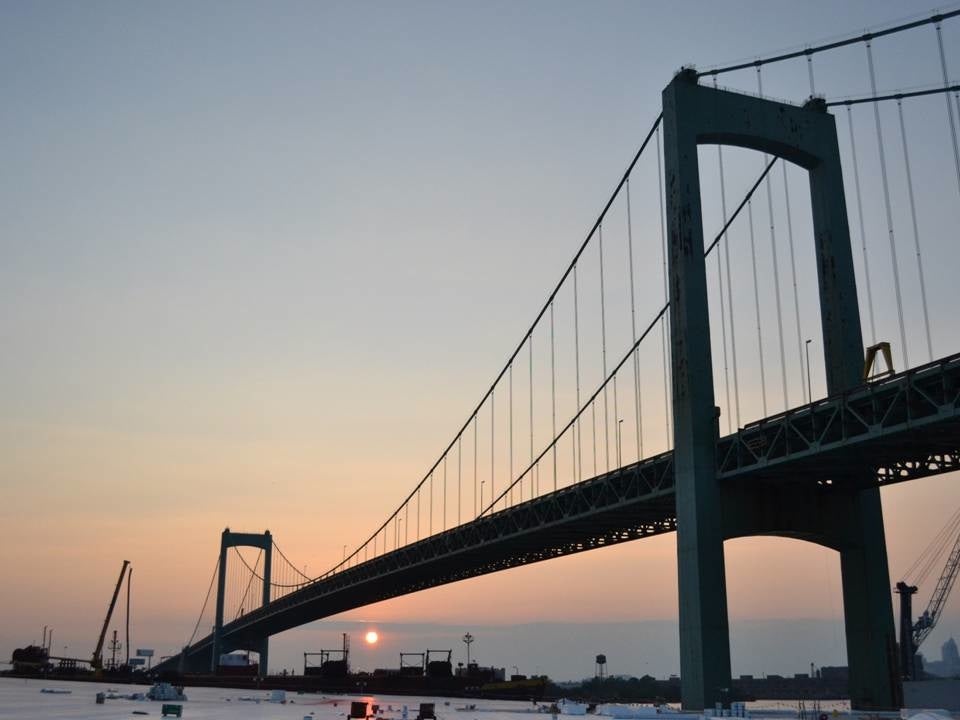Construction work advances on Walt Whitman Bridge
If the three-year construction project on the Walt Whitman Bridge has added a bit of a headache to your daily commute, you may be pleased to know the toughest phase is complete.
Construction on the Walt Whitman Bridge moved into phase five as crews began re-decking the fifth of the bridge’s seven lanes in late September.
The three-year construction project will completely replace the Walt Whitman’s original, 55-year-old deck with a new “floating” deck – a first for Philadelphia’s Delaware River bridges. The new deck is a lightweight concrete filled, jointless deck, which creates a smoother rider for motorists. Because it is jointless, there are also fewer spots for water or sewage to seep in, Chief Engineer Mike Venuto said.
Unlike many construction projects around the city, this nearly $140 million project did not receive any federal funding. The Delaware River Port Authority awarded the construction contract to American Bridge Company and the construction oversight contract to Urban Engineers Inc. and URS Corporation in 2010.
“The phase we just left was our most challenging because we only had three lanes of traffic in each direction,” Venuto said.
Phase five will allow crews to manage traffic flow as they had in phases one through three by creating four lanes of traffic heading into Philadelphia during peak morning rush hour and three lanes in each direction during evening rush hour. Because phase four involved re-decking the middle lane, this type of traffic management has not been possible for the past few months.
Venuto said he is pleased with the progress of the work so far.
“We haven’t been overwhelmed with any problems,” he said. “ I think we’ve done a good job of keeping traffic moving. We’ve done a good job of taking proactive measures.”
Some of those proactive measures include displaying variable message signs advising motorists of traffic changes and delays, implementing a highway advisory radio station, having a tow truck onsite whenever a “cattle chute,” or traffic bounded by barriers, is in place and encouraging off peak travel.
During phase five, crews will continue to install the new deck, remove the old suspended span, make structural improvements, install new parapets and use the new steel shell, moveable barrier.
This phase is expected to take three to four months and to wrap up in December or January. Venuto said he does not anticipate any winter shut downs and has winter provisions in place.
When construction is completed in the spring of 2014, Venuto hopes the only change motorists will only notice is a smoother, hassle-free ride.
“When Mike and his team do their job best, motorists take them for granted,” said Tim Ireland, DRPA director of corporate communications. “The goal is to be taken for granted.”
Though this is certainly one of the largest upkeep projects for the Walt Whitman Bridge, Venuto said “a bridge of this size, this age requires continual maintenance, continual upgrades.”
Following completion the re-decking, removal of the temporary gantries, installation of permanent gantries and removal of the work platform beneath the bridge, crews will begin painting the suspended portion of the bridge. This work will have much less of an impact on traffic patterns.
“The next major priority is the painting and in the years to come following the painting we’re looking at the main cable and ways to preserve the main cable,” Venuto said.
The projected lifespan of the new deck is between 60 and 75 years.
Contact the reporter at cfisher@planphilly.com
WHYY is your source for fact-based, in-depth journalism and information. As a nonprofit organization, we rely on financial support from readers like you. Please give today.









